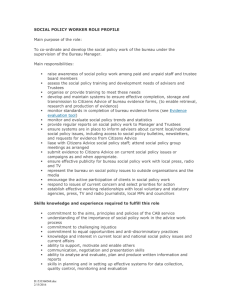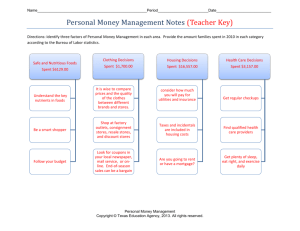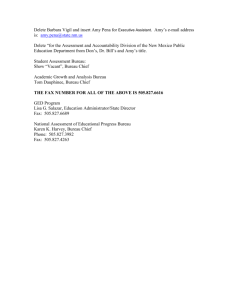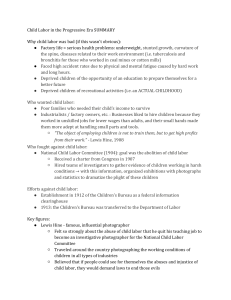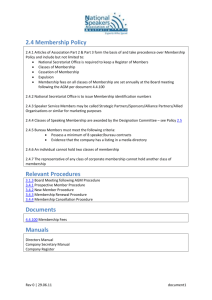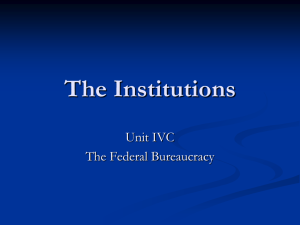LSN 25_Ch 9 notes
advertisement
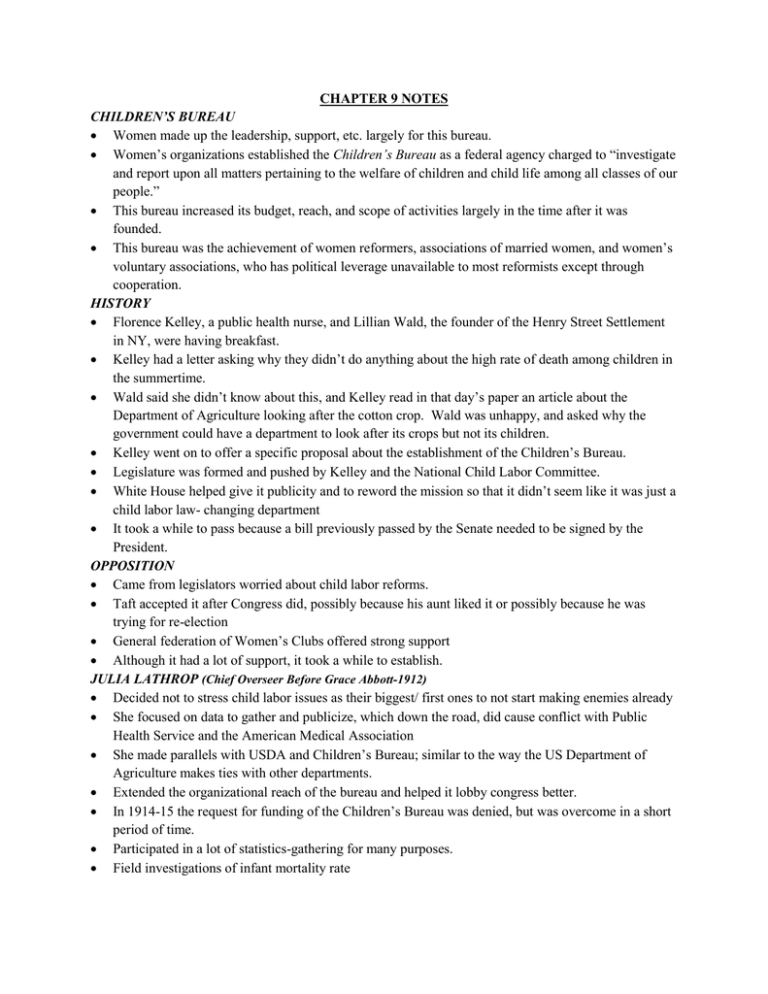
CHAPTER 9 NOTES CHILDREN’S BUREAU Women made up the leadership, support, etc. largely for this bureau. Women’s organizations established the Children’s Bureau as a federal agency charged to “investigate and report upon all matters pertaining to the welfare of children and child life among all classes of our people.” This bureau increased its budget, reach, and scope of activities largely in the time after it was founded. This bureau was the achievement of women reformers, associations of married women, and women’s voluntary associations, who has political leverage unavailable to most reformists except through cooperation. HISTORY Florence Kelley, a public health nurse, and Lillian Wald, the founder of the Henry Street Settlement in NY, were having breakfast. Kelley had a letter asking why they didn’t do anything about the high rate of death among children in the summertime. Wald said she didn’t know about this, and Kelley read in that day’s paper an article about the Department of Agriculture looking after the cotton crop. Wald was unhappy, and asked why the government could have a department to look after its crops but not its children. Kelley went on to offer a specific proposal about the establishment of the Children’s Bureau. Legislature was formed and pushed by Kelley and the National Child Labor Committee. White House helped give it publicity and to reword the mission so that it didn’t seem like it was just a child labor law- changing department It took a while to pass because a bill previously passed by the Senate needed to be signed by the President. OPPOSITION Came from legislators worried about child labor reforms. Taft accepted it after Congress did, possibly because his aunt liked it or possibly because he was trying for re-election General federation of Women’s Clubs offered strong support Although it had a lot of support, it took a while to establish. JULIA LATHROP (Chief Overseer Before Grace Abbott-1912) Decided not to stress child labor issues as their biggest/ first ones to not start making enemies already She focused on data to gather and publicize, which down the road, did cause conflict with Public Health Service and the American Medical Association She made parallels with USDA and Children’s Bureau; similar to the way the US Department of Agriculture makes ties with other departments. Extended the organizational reach of the bureau and helped it lobby congress better. In 1914-15 the request for funding of the Children’s Bureau was denied, but was overcome in a short period of time. Participated in a lot of statistics-gathering for many purposes. Field investigations of infant mortality rate Despite opposition, Lathrap’s plan to make friends with other organizations paid off because she had their support when she needed it. Bureau kept local communities working at improved infant and maternal health They also had the help of the General Federation of Women’s Clubs and sponsored “Baby Week” in March 1916 Lathrop decided to replicate the “Smith-Lever Act” used by the USDA in order to try to supply states with matching funds to help support education of mothers about supporting themselves and their infants. 1918-1919 “The Year of the Child” set a list of standards for child welfare in America. SHEPPARD-TOWNER ACT (1921) Also known as: “Federal Act for the Promotion for the Welfare and Hygiene of Maternity and Infancy” Was supported by Senator Morris Sheppard of Texas and Representative Horace Mann Towner of Iowa Not for charity – specifically for education purposes and so that services would be available to all (as opposed to an outreach program). It was successful compared to other social welfare programs because: o It was not passed during WWI as an emergency measure, preventing large oppositions from growing o Benefited from a large build-up of support (magazines, women’s clubs, churches, charities, etc.) o Highly successful coordinated lobbying in Congress by the women’s associations. (fear in Congress of losing positive numbers in the polls for not supporting this) GRACE ABBOTT (1922) Talks about responsibility of women’s clubs to support measures taken for the welfare of children. No single-model plan; each state would form the Sheppard-Towner Act to be what they needed it to be. APRIL 5, 1926- The Beginning of the End Extension of funds passes in the House of Representatives but fails in the Senate largely due to private physicians and the American Medical Association. Extend funding for one more year, and then after that it continued the program for 2 more years under the Maternity and Infancy Act, after which the Sheppard-Towner Act would also be removed They tried over 14 different bills to try to get something reinstated but nothing worked. Finally, it was decided in 1930 that the Public Health Service would take over all new programs. States attempted to unsuccessfully hang on for a while during the time this was in Congress, but they didn’t have enough funds to meet what they had had in the past. The Act had failed, according to some, because private physicians finally found it appropriate to offer preventive health services and offer advice on personal hygiene, and women (who had previously been considered primary health-givers) were no longer needed as such.
